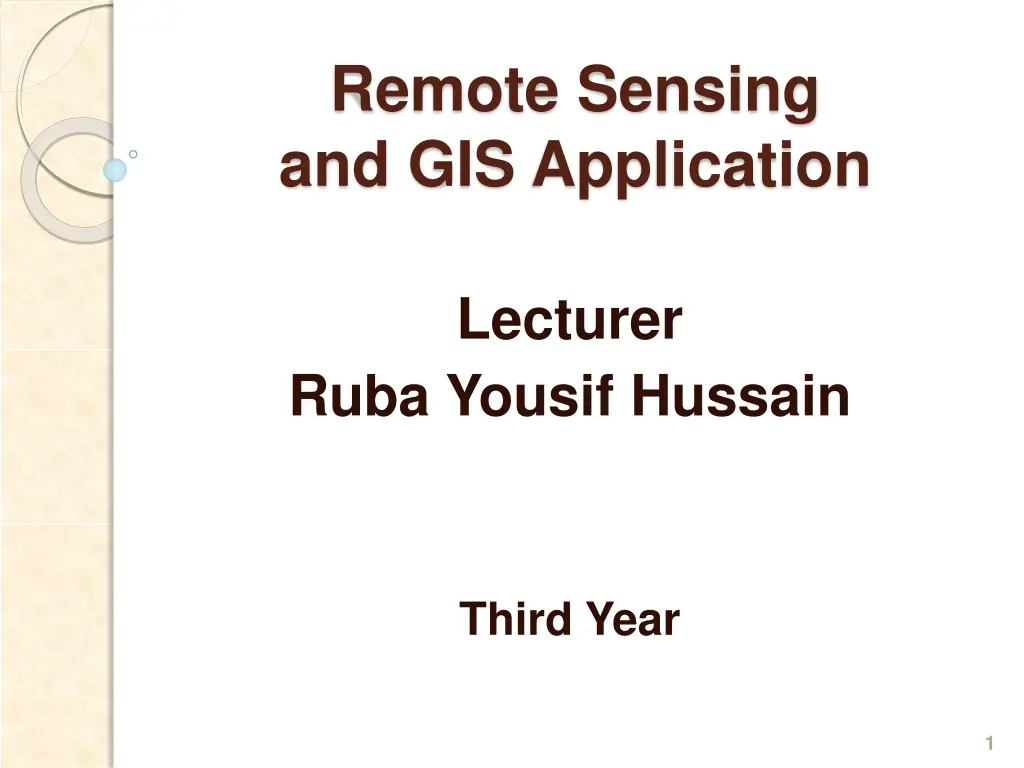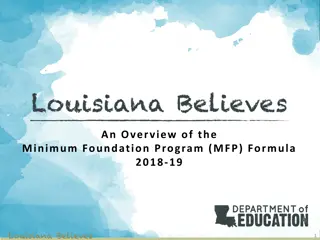
Geospatial Applications in Remote Sensing and GIS
Explore the applications of Remote Sensing and GIS through the teachings of Lecturer Ruba Yousif Hussain, emphasizing GIS fundamentals, spatial data organization, GIS technologies, and GIS programs such as ESRI ArcGIS and QGIS. Understand the comparison between GIS and CAD, the components of a GIS, and the types of map information in a GIS environment.
Download Presentation

Please find below an Image/Link to download the presentation.
The content on the website is provided AS IS for your information and personal use only. It may not be sold, licensed, or shared on other websites without obtaining consent from the author. If you encounter any issues during the download, it is possible that the publisher has removed the file from their server.
You are allowed to download the files provided on this website for personal or commercial use, subject to the condition that they are used lawfully. All files are the property of their respective owners.
The content on the website is provided AS IS for your information and personal use only. It may not be sold, licensed, or shared on other websites without obtaining consent from the author.
E N D
Presentation Transcript
Remote Sensing and GIS Application Lecturer Ruba Yousif Hussain Third Year 1
Remote Sensing and GIS Application Lecturer Third Year Ruba Yousif Hussain Geographical Information System ( GIS) Geographical information System ( GIS ) GIS is an information management process for organizing spatially related data so that it can be analyzed and displayed. The data are stored in different layers , which can be overlaid to assess their interrelationship. Layers Layers are the mechanism used to display geographic datasets in ArcMap, ArcGlobe, and ArcScene. Each layer references a dataset and specifies how that dataset is portrayed using symbols and text labels. When you add a layer to a map, you specify its dataset and set its map symbols and labeling properties. 2
Remote Sensing and GIS Application Lecturer Third Year Ruba Yousif Hussain 3
Remote Sensing and GIS Application Lecturer Third Year Ruba Yousif Hussain LIS ( Land Information System ) , which deal exclusively with parcel title description and registration. Automated Mapping and Facility Management ( AM / FM ), which models the location of all utility / plant facilities; Transportation design and management (GIS-T) How do GIS and computer-assisted drafting/design (CAD) compare? Both systems are computer-based, but CAD is often associated with higher precision engineering design and surveying applications, and GIS is more often associated with mapping and planning-activities requiring lower levels of precision . CAD is similar to mapping because it is essentially an inventory of entered data and computed data that can provide answers to the question , Where is it located ? GIS can model data and provide answers to the spatial and temporal questions like, What occurred? What if? Topology gives GIS the ability to determine spatial relationships , such as adjacency and connectivity, between physical features or entities. GIS adds the analytical capabilities ( graphic and attribute ) while automated cartography and CAD lack ( graphic only ). 4
Remote Sensing and GIS Application Lecturer Third Year Ruba Yousif Hussain GIS programs 1.ESRI ArcGIS 2. ArcView 3. QGIS ESRI ( Environmental Systems Research Institute ) GIS Activities 1. Data collection and input. 2. Data storage and retrieval. 3. Data analysis. 4. Data output and display. 5
Remote Sensing and GIS Application Lecturer Third Year Ruba Yousif Hussain Components of a GIS 1- Computer 2- Data collection 3- Software 4- Hardware Data Information There are two basic types of map information in a GIS : Spatial and Aspatial ( Descriptive attribute ) 1- Spatial refers to geographic features that are represented as rater ( pixel ) or vector ( points , Lines , and Polygons ). 2- Aspatial or Descriptive refers to tabular data which records characteristics of the geographic features. Hardware - Input ( Keyboard , mouse , light pen , digitizer , scanner , sound ) - Processing ( Central processing unit , CPU single / multiple ) - Storage ( Magnetic and optical media , hard disk , CD ROM ) - Output ( Screen , LCD projector , sound system , printer , plotter ) 6
Remote Sensing and GIS Application Lecturer Third Year Ruba Yousif Hussain Software - Operating system ( OS ) - Graphic software ( CAD , Microstation ) - Database softwate ( dBASE , Oracle ) - Statistical packages ( SPSS , SAS , Minitab ) - Word Processing ( MS Word , Word Perfect ) - Image Processing ( IDRISI , ER Mapper , ERDAS ) - GIS Systems ( ArcInfo , ArcView , MapInfo ) - Presentation ( MS Power Point , SCALA , Coral Draw ) Sources for GIS Data 1- Field surveying. 2- Remotely sensed images 3- Topographic maps, plans, and photos via digitizing and/or scanning. 4- Census data. Spatial Entities or Features Spatial data have two characteristics location and descriptive attributes. In GIS, entities are modeled as either points , lines, or areas ( polygons ). 7
Remote Sensing and GIS Application Lecturer Third Year Ruba Yousif Hussain Advantages of GIS - Time Minimization - Accuracy Improvement - Data can be managed efficiency - High cost / benefit ratio GIS functions. - Data acquisition ( spatial and non spatial ) - Data processing ( data management ) - Data analysis ( spatial and statistical analysis ) - Data storage ( store data more efficiency ) - Data output ( Maps , graphs , tables , reports ) 8
Remote Sensing and GIS Application Lecturer Third Year Ruba Yousif Hussain Commands and Tools Commands do not require interaction with the map , they just rely on surface. Tools require interaction with map canvas. Difference between GPS and GIS GPS ( Global Positioning System ) uses satellites that orbit earth to send information to GPS receivers that are on the ground. The information helps people determine their location. GIS ( Geographic Information System ) stands for Geographical Information System.GIS is a software program that helps people use the information that is collected from the GPS satellites. 9
Remote Sensing and GIS Application Lecturer Third Year Ruba Yousif Hussain Laboratory ArcGIS Programs and Interface Purpose Learning ArcGIS Programs and Interface. Application ArcGIS Tutorial ArcGIS consists from the following main programs: ( a ) 10
Remote Sensing and GIS Application Lecturer Third Year Ruba Yousif Hussain Start ArcGIS ( b ) Figure 2 ArcGIS Programs 11
Remote Sensing and GIS Application Lecturer Third Year Ruba Yousif Hussain ArcCatalog ArcCatalog is the application for managing your spatial data holdings, for managing you database designs, and for recording and viewing metadata. Figure 3 ArcCatalog 12
Remote Sensing and GIS Application Lecturer Third Year Ruba Yousif Hussain ArcMAP ArcMap is used for all mapping and editing tasks as well as for map-based analysis. Figure 4 ArcMap Interface 13
Remote Sensing and GIS Application Lecturer Third Year Ruba Yousif Hussain Opening a Map Document (a) (b) 14
Remote Sensing and GIS Application Lecturer Third Year Ruba Yousif Hussain (c) Figure 5 Opening a Map Document 15
Remote Sensing and GIS Application Lecturer Third Year Ruba Yousif Hussain Creating a New Map Document (a) 16
Remote Sensing and GIS Application Lecturer Third Year Ruba Yousif Hussain (b) Figure 6 Creating a New Map Document 17
Remote Sensing and GIS Application Lecturer Third Year Ruba Yousif Hussain Add and Hide Toolbar Figure 7 Add and Hide Toolbar 18






















